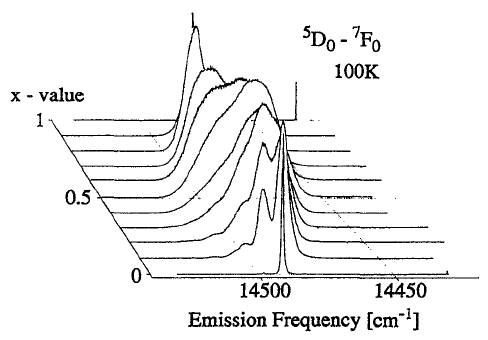The growth of thin films made from Samarium-doped alkaline earth fluoro halides (AEFH) of composition SrxCa1−xFCl:Sm2+ (0 ⩽ x ⩽ 1) is presented and the possibilities are studied to increase significantly the inhomogeneous width of the Sm2+ optical zero phonon transitions. The best films were obtained when grown with a molecular beam deposition (MBD) method involving two separate molecular beams: one for the alkaline earth fluoride, the other one for the alkaline earth halide (Cl or Br). The results demonstrate that the double beam MBD technique employed is able to produce pure and mixed Matlockite films with targeted composition. The results of mainly optical studies of the samarium f–f transitions and of other complementary techniques are used to assess the composition and homogeneity of the films. With the aid of a model the composition dependence of the positions of specific optical f–f emission lines is established. Their inhomogeneous linewidth is compared with that of corresponding emission lines obtained from bulk samples of the same chemical composition. The linewidths of the films are only slightly larger (∼1.5–2 times). Thus, the film morphology cannot be exploited to increase substantially the inhomogeneous broadening of the luminescence lines. A novel approach to increase this broadening was devised, theoretically modeled and successfully tested by using multilayered sandwich-type thin films in conjunction with interdiffusion. Films with cation disorder of composition SrxCa1−xFCl (x = 0.5 /0/ 0.5/ 0/..) were grown. The 5D1→7F0 Sm2+ emission linewidth is thereby increased to 70 cm−1 full width half maximum. A width of 100cm−1 may be obtained within the composition range x = 0, x = 1. This represents an enhancement by a factor of 3–5 in comparison with the largest values obtained in appropriate mixed bulk AEFH of constant composition. A factor >50 is gained in comparison with pure bulk AEFH hosts. The room temperature (RT) homogeneous linewidths, on the other hand, are similar to those found in bulk mixed crystals of constant composition. The intrafilm host cation diffusion during film growth of the sandwich structures was further studied. A diffusion constant of 2⋅10−19m2s−1 for the Sr and Ca ions was deduced from this observation. These films are among the most promising materials for optical mass data storage through RT hole-burning. |




